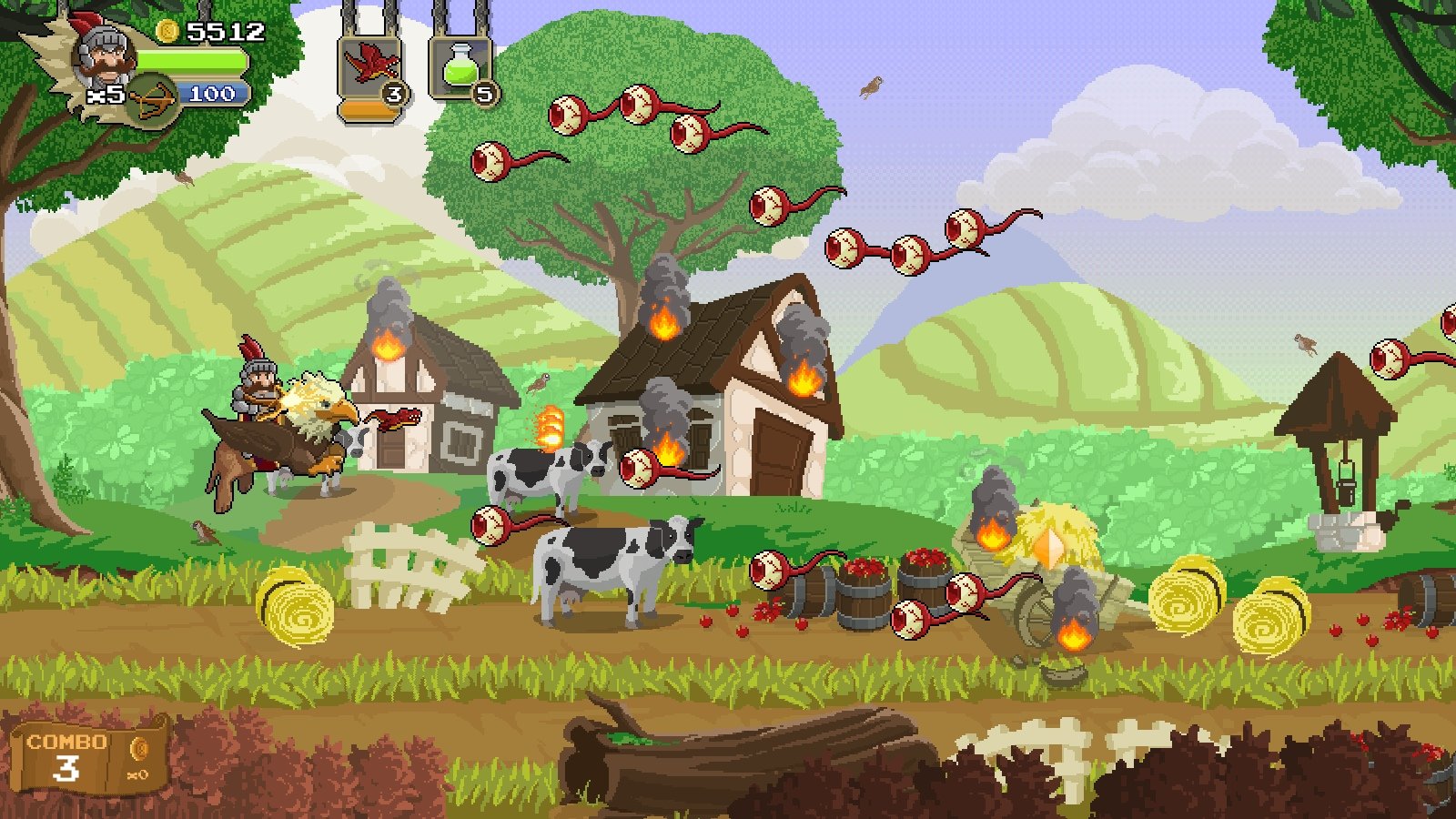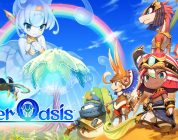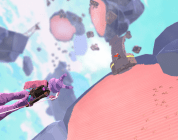Years ago, shoot-em-ups ruled the land, with titles such as Galaga, Contra, Metal Slug, etc. Since then, very few have emerged, and even fewer have been worthwhile. Enter Gryphon Knight Epic, a 2-D shoot-em-up title. Like most games these days, Gryphon Knight Epic started out as a humble Kickstarter campaign, but since has grown. While it may have started on PC, it is now venturing onto consoles. Many people liked the title for PC, but does the charm translate well to consoles? My answer: how did it take this long to get onto consoles because this game was made for it.
While it is far from perfect for multiple reasons, this title charmed me (much like the weapons in the game charmed their wielders) to enjoy it. I started off with low expectations, because this title was said to be a mixture of Galaga and Mega Man. While I enjoyed Galaga, I never quite got into Mega Man, but that does not overly matter. You start your journey as Sir Oliver, a knight of the king who is sent out to save the princess from a menacing dragon with friends from around the kingdom. You rescue her and fall madly in love while your friends loot the dragon’s cave for its magical weapons. By the time Sir Oliver realizes what has happened, there is only an amulet left. Years later, peace has overcome the kingdom, and Sir Oliver and his Princess wife welcome a baby boy into the world. (a baby boy with as much of a glorious mustache as Oliver.) From here, you are sent to get milk for your Princess, (yes, such a noble quest.) so you and your Gryphon Aquilla head out to satisfy your wife’s thirst. This is where our game starts, to a bit of a slow start.
From here, you are introduced to the mechanics of the game: the screen scrolls in the direction you face, you can move around the screen on Aquilla, and you can shoot the direction you are facing. While this is simple, it is one of the biggest shortcomings I found in this title. If an enemy gets behind you, you must turn around to shoot it. Since you turn around to shoot it, your screen starts panning in the opposite direction than what you were originally going. While it makes sense, it was extremely frustrating in practice. There were multiple times I lost health from switching and immediately running into an enemy/obstacle thanks to the way the screen shifted. You progress through the tutorial to meet your Specter who wants to rule the kingdom and end your life. This is the first boss fight of the game and they do something that I cannot stand: you are not intended to win this fight. You are expected to lose to progress the story. The redeeming quality is that you can actually come back later in the game after you have upgraded your weapons and defeat him for an achievement, which was nice, but it does not affect the story in any means.
This brings me to the topic of the upgrades in the game. You start off with just a crossbow that can be charged up and is your main weapon. As you progress through the game and defeat your friends who have been taken over by the objects, you will earn their weapons to help you on your journey, this weapons can be upgraded and taken back to previous levels to help earn money or even help you find alternate paths. Each weapon has its own design, and abilities that make them unique and useful in different situations.You use gold which is earned throughout your quest to upgrade these items. My favorite part of the gold system is that there are areas where you are able to farm for gold and help make your quest easier/more enjoyable. In each area, there is a hidden rune which will do the same as the items. They can be upgraded, and will make your quest easier as they are upgraded. For example, there is a stone that will allow you to breathe underwater, as well as under sand which opens up alternate paths with great rewards. This system allows you to be more explorative in each level, instead of just going through without really looking.
While the game makes upgrading nice and simple, that only really counts if the gameplay is good, and it is…for the most part. Each level has unique enemies to face off against based on the setting and the situation in the area caused by the main boss. (Jungle Level has alligators that throw spears, Desert has vultures, Storming the tower has aliens because the boss ripped open alternate dimension portals.) The biggest problem to the gameplay was mentioned before with the inability to travel one direction and shoot the other.
Each area is unique with respect to design, enemies, and music, but the music was definitely the weakest of the three. There are 8 different levels to explore in this title, and trust me, you will want to explore them. While it is catchy while playing, it probably won’t leave a lasting impression in the long run. Which isn’t bad, because it gets the job done, but not much more than that.
The biggest draw for some people is the fact that this game can be difficult due to the almost “bulletstorm” style at times. There are a lot of enemies that can be on the screen at once, and when you are being shot at by 7 different enemies, it gets hectic. Each level has three difficulties which affects the gold gained in the level, as well as how many hits it takes you to die. The art style allows the screen to be engulfed by different actions, but not clustered most of the time. The way the game colors itself is beautiful in itself, in a unique retro experience.
While it does have its issues with music and traversing, the title made me want to keep playing it and complete it. It was a refreshing take at a game genre that has been missing for a while. Combine this with the $9.99 price tag, and you would be a fool to pass it up. This is why I give Gryphon Knight Epic an 8.3 out of 10.







